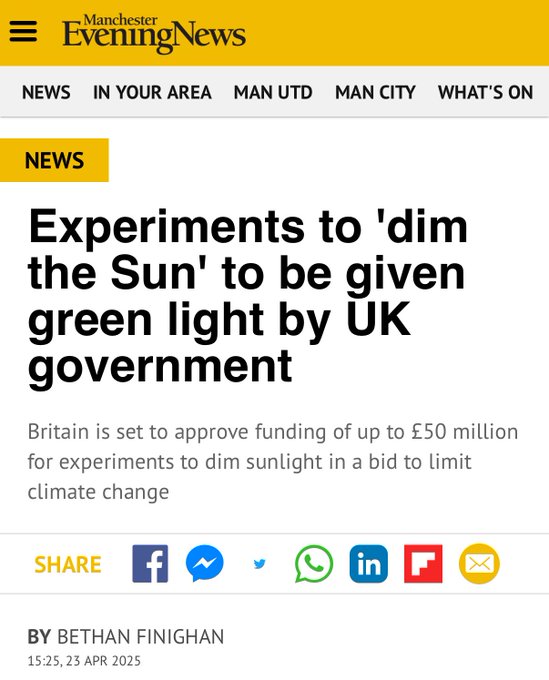
Key takeaways:
- The research focuses on several key techniques, including Stratospheric Aerosol Injection (SAI) using non-toxic substances like cellulose nanocrystals and potentially sulfur dioxide, Marine Cloud Brightening (MCB) using sea-salt particles, and Cirrus Cloud Thinning with as yet unspecified seeding materials
- As of late April 2025, the specific locations for outdoor experiments had not been publicly announced, with announcements anticipated in the near future.
- Critics say dimming the sun is “a very bad idea”, others argue that “I don’t remember anyone voting for this”. Many people are asking “Who’s accountable when it goes wrong?”
26 APRIL 2025: The UK government has approved £56.8 million ($71.5 million) for a series of controversial outdoor experiments to test “sun-dimming” technologies aimed at cooling the Earth, officials confirmed this week. The tests, set to begin within weeks, will involve spraying reflective particles including sulfur dioxide into the atmosphere to block incoming sunlight.
BREAKING: 🚨 THE UK IS ABOUT TO TRY AND “DIM THE SUN” 🚨
— Jim Ferguson (@JimFergusonUK) April 24, 2025
Yes, you read that right.
🌫️ In the next few days, Britain will begin geoengineering experiments to block sunlight from reaching the earth — in a scheme straight out of a dystopian sci-fi novel.
💰 Funded and championed… pic.twitter.com/RJok1jdne3
The program, called “Exploring Climate Cooling,” will be run by the UK’s Advanced Research and Invention Agency (ARIA) and represents one of the largest government investments in solar geoengineering research globally. The announcement has sparked intense debate among scientists, environmentalists and policymakers about the risks and ethics of deliberately manipulating Earth’s climate system.
“We face significant risk of triggering temperature-induced climate tipping points,” said Professor Mark Symes, the program’s director. “We need to explore safe and responsible methods for cooling the Earth to prevent potentially catastrophic shifts in our climate system.”


In this article
- 1 About the “Exploring Climate Cooling” Programme
- 2 What the experiments will involve
- 3 Chemicals Planned for Use in Solar Dimming Experiments
- 4 Location of the Experiments
- 5 Scientific debate intensifies
- 6 Chemicals and monitoring
- 7 Ecological Impact Assessments
- 8 Human Health Testing
- 9 Animal and Plant Life
- 10 Potential Negative Consequences of Sulfur Dioxide Spraying
- 11 Potential Negative Consequences of Sea Salt Particle Spraying
- 12 Governance and oversight
- 13 Public reaction and controversy
- 14 International response
- 15 Environmental Impact and Ethical Considerations
- 16 Looking ahead
- 17 Fact check
About the “Exploring Climate Cooling” Programme
The “Exploring Climate Cooling” programme represents a significant undertaking by the United Kingdom’s Advanced Research and Invention Agency (ARIA), with a budget of £56.8 million dedicated to investigating the potential of climate engineering technologies. various approaches aimed at delaying or even averting critical climate tipping points. The programme’s inception is rooted in the growing concern that global temperature increases could trigger irreversible changes in the Earth’s climate system, despite the ongoing efforts to reduce greenhouse gas emissions through decarbonization.
The substantial financial commitment to this programme, alongside the £10.5 million investment by the Natural Environment Research Council (NERC) in related solar radiation management (SRM) research, underscores a considerable strategic prioritization by the UK government in the field of solar geoengineering as a potential climate intervention strategy.
It’s interesting they call it “dimming the sun”. The sun will be completely unaffected by what they’re doing. It’s the Earth they’re dimming. Our planet. Our daylight. Our lives. That’s what will be dimmed.
A central focus of the “Exploring Climate Cooling” programme is the investigation of methods to specifically delay or avert critical climate tipping points. These include potentially catastrophic events such as the collapse of major ocean current systems or the disintegration of large ice sheets. Professor Mark Symes, the Programme Director, has emphasized the significant risk of triggering temperature-induced climate tipping points and the consequent necessity to explore safe and responsible methods for cooling the Earth.
What the experiments will involve
The UK program will test three main approaches to reflecting sunlight away from Earth:
- Stratospheric Aerosol Injection (SAI), which involves releasing reflective particles like sulfur dioxide or cellulose nanocrystals into the upper atmosphere to mimic the cooling effect of volcanic eruptions.
- Marine Cloud Brightening (MCB), which aims to make low-lying clouds over oceans more reflective by spraying fine sea salt particles into the air.
- Cirrus Cloud Thinning, which seeks to reduce the insulating effect of high-altitude cirrus clouds to allow more heat to escape into space.
Initial outdoor experiments will be conducted on a “small scale” and “geographically confined” basis, according to ARIA documents, potentially covering areas only a few hundred meters in size. The specific test locations have not yet been announced, though officials said communities near potential sites would be consulted before any experiments begin.
Chemicals Planned for Use in Solar Dimming Experiments
The “Exploring Climate Cooling” programme is considering several approaches to solar radiation management (SRM), each with its own set of potential chemicals or materials for experimentation.
| Method of Solar Dimming | Potential Chemicals/Materials | Mechanism of Action |
| Stratospheric Aerosol Injection (SAI) | Sulfur dioxide, Cellulose nanocrystals (CNCs), Titanium, Aluminum | Reflecting sunlight back into space by increasing the concentration of reflective particles in the stratosphere |
| Marine Cloud Brightening (MCB) | Sea-salt particles | Increasing the reflectivity of low-lying marine clouds by increasing the number of cloud condensation nuclei |
| Cirrus Cloud Thinning | Sea salt, Bismuth triiodide (potential) | Reducing the optical thickness of cirrus clouds to allow more longwave radiation to escape into space |
Stratospheric Aerosol Injection (SAI)
Stratospheric Aerosol Injection (SAI) is a primary method under investigation, which involves introducing reflective particles into the upper layers of the atmosphere, specifically the stratosphere, to reflect a portion of incoming sunlight back into space. Among the potential chemicals for SAI, sulfur dioxide is frequently mentioned in the context of mimicking the cooling effects observed after large volcanic eruptions. These eruptions naturally release significant amounts of sulfur dioxide into the stratosphere, leading to the formation of sulfate aerosols that can reflect sunlight and cause a temporary cooling effect on the planet.
The programme is also exploring the use of alternative materials, such as cellulose nanocrystals (CNCs). CNCs are bio-based materials derived from cellulose, which could offer a potentially more sustainable and environmentally friendly alternative to traditional sulfur-based aerosols. Additionally, research in the broader field of SAI has considered other reflective minerals, including titanium and aluminum, although their use in this specific UK programme is not explicitly detailed.
A critical aspect of the programme’s approach is the commitment to environmental safety. ARIA has stated that it will not provide funding for any research that involves the release of toxic substances into the environment. This constraint suggests that while various chemicals might be considered for their reflective properties, the final selection will likely prioritize substances with minimal potential for harmful environmental impacts. The inclusion of CNCs in the research indicates an active consideration of greener alternatives to traditional aerosols.
Marine Cloud Brightening (MCB)
Another significant area of focus within the “Exploring Climate Cooling” programme is Marine Cloud Brightening (MCB). This technique aims to enhance the reflectivity of low-lying clouds over the ocean by spraying seawater into the atmosphere. The primary material proposed for MCB is sea salt, which, when sprayed in the form of fine particles, acts as cloud condensation nuclei. An increase in these nuclei leads to the formation of more numerous and smaller water droplets within the clouds, making them brighter and thus more effective at reflecting sunlight back into space.
MCB is often viewed as a more environmentally benign approach compared to SAI, as it utilizes a naturally occurring substance – sea salt – and targets clouds in the lower atmosphere. Research in this area will likely concentrate on determining the optimal size and distribution of the sea-salt particles to achieve the maximum increase in cloud reflectivity without causing adverse effects on cloud properties or precipitation patterns. The concept behind MCB is partly inspired by the observation of brighter clouds forming over shipping lanes due to pollution particles acting as cloud condensation nuclei. The planned experiments aim to replicate this effect in a controlled manner using sea salt.
Cirrus Cloud Thinning
Cirrus Cloud Thinning is another potential solar dimming technique that the UK programme might explore. This method involves seeding high-altitude cirrus clouds to reduce their thickness, thereby allowing more longwave radiation (heat) to escape from the Earth into space. Cirrus clouds, while reflecting some incoming sunlight, have a net warming effect on the planet because they are more effective at trapping outgoing heat. Thinning these clouds could potentially lead to a cooling effect.
The specific seeding materials that might be used for cirrus cloud thinning are not explicitly detailed in the provided research snippets. However, broader research in this area has considered various substances, ranging from environmentally benign materials like sea salt to more controversial but potentially more effective substances like bismuth triiodide. The lack of specific information in the snippets suggests that research into cirrus cloud thinning might be at a more preliminary stage within the “Exploring Climate Cooling” programme compared to SAI and MCB.
Location of the Experiments
As of late April 2025, when the majority of the provided research material was published, the specific locations for any planned outdoor experiments under the UK’s “Exploring Climate Cooling” programme had not been officially announced. Professor Mark Symes, the Programme Director, indicated that further announcements regarding the recipients of funding and the potential locations for outdoor experiments were expected to be made in the near future. This suggests that while the programme is moving forward with its research plans, the specific geographical areas where outdoor testing might occur were not yet in the public domain at that time.
The “Exploring Climate Cooling” programme emphasizes that any outdoor experimentation will be conducted on a small scale and will be geographically confined. Initial trials, particularly for techniques like marine cloud brightening, are anticipated to be very localized, potentially on the order of a few hundred meters.
Scientific debate intensifies
The approval has ignited a fierce debate in the scientific community, with critics warning of potentially devastating unintended consequences.
“This is climate warfare, not climate science,” said Dr. Elena Ramirez, environmental scientist at Oxford University, who was not involved in the program. “Spraying sulfur dioxide – the same pollutant that causes acid rain – into our atmosphere could disrupt global weather patterns, cause severe droughts in Africa and Asia, damage the ozone layer, and affect food production for billions of people.”
Other experts point to what they call the “termination effect” – if sun-dimming technologies were deployed at large scale and then suddenly stopped, Earth could experience rapid warming that would overwhelm natural and human systems.
Supporters counter that such research is urgently needed as the planet approaches dangerous climate tipping points – thresholds that, once crossed, could trigger catastrophic and irreversible changes such as the collapse of major ocean currents or disintegration of ice sheets.
“We’re not talking about deployment,” emphasized Dr. William Chen, climate scientist at Imperial College London and consultant to the ARIA program. “These are carefully controlled experiments to gather crucial data about whether these approaches are even viable and what their impacts might be. We need this information before climate emergencies force hasty decisions.”
Chemicals and monitoring
Documents outlining the program indicate researchers will test several chemicals, including sulfur dioxide, sea salt particles, and cellulose nanocrystals – materials derived from wood or cotton that could potentially offer a more environmentally friendly alternative to traditional sulfur-based aerosols.
ARIA has pledged not to fund any research involving toxic substances and will publish comprehensive environmental impact assessments before outdoor experiments begin. The program will follow a “predict → test → monitor → validate” framework, using a combination of ground-based sensors, atmospheric monitoring stations, and satellite data to track the effects of the experiments.
“All data generated from this research will be made publicly available,” said Sarah Thompson, ARIA spokesperson. “We’re committed to complete transparency in our methods, findings, and any potential impacts observed.”
Ecological Impact Assessments
A key mechanism for evaluating the potential ecological consequences of the experiments will be the publication of environmental impact assessments (EIAs) prior to the commencement of any outdoor testing. These assessments will aim to identify and evaluate the potential risks and benefits of the experiments on the local environment and ecosystems.
This requirement underscores a proactive approach to understanding and mitigating any adverse ecological consequences. The programme’s overarching commitment to minimizing risk by design also includes a focus on reducing potential risks to the local environment and ecosystems.
Human Health Testing
The research material does not outline specific protocols for direct testing of the effects of the solar dimming experiments on human health. However, the programme’s commitment to responsible research practices and the overarching principle of minimizing risk strongly imply that potential impacts on human health will be carefully considered throughout the research and governance processes.
While direct human health testing protocols are not explicitly mentioned, the broad scope of the ethical and societal considerations likely includes an evaluation of potential risks to human health, even if direct experimentation is not planned at this early research stage.
The following table summarizes the potential risks associated with each chemical:
| Chemical | Respiratory Issues | Acid Rain | Cardiovascular Risks | Other Health Risks |
| Sulfur Dioxide | High | Yes | Yes | |
| Calcium Carbonate | Moderate | No | No | Lung calcification (long-term) |
| Sea Salt | Potential | No | Potential | Potential impact on marine ecosystems |
| Cellulose Nanocrystals | Potential | No | Potential | Reproductive toxicity (animal studies) |
| Aluminum Oxide | High | No | Potential | Metal fume fever, potential link to Alzheimer’s |
| Sulfuric Acid | High | Yes | Potential | Severe irritation, burns |
| Barium | Yes | No | Yes | Neurological, gastrointestinal, muscular effects |
| Iron | No clear evidence | No | No |
Animal and Plant Life
Similar to the approach for human health, the research snippets do not detail specific testing protocols for evaluating the effects of the solar dimming experiments on animal and plant life.
The programme’s commitment to protecting the local environment inherently includes considering the well-being of the animal and plant populations within the areas where experiments might occur.
Potential Negative Consequences of Sulfur Dioxide Spraying
Spraying large quantities of sulfur dioxide carries the risk of severe and widespread droughts, particularly in Africa and Asia, potentially impacting billions of people’s access to food and water. It could also disrupt global weather patterns, including vital rainfall needed for agriculture, leading to crop failures and famine.
Furthermore, SAI might impact extreme weather events and could lead to ozone depletion, increasing harmful UV radiation. A significant concern is the “termination effect,” where an abrupt stop to spraying could cause rapid temperature and precipitation increases, overwhelming natural and human systems.
Potential Negative Consequences of Sea Salt Particle Spraying
Spraying large quantities of fine sea salt particles over the ocean could lead to unintended alterations in regional and global precipitation patterns, potentially disrupting monsoons crucial for agriculture. It might also cause uneven cooling, overcooling the tropics while other regions still warm.
There’s a risk of “marine sky brightening,” reducing the effectiveness of cloud brightening, and the long-term effects on marine ecosystems are not fully understood. Changes in cloud properties could also have unforeseen consequences for cloud lifetime and precipitation.
Governance and oversight
To address ethical concerns, ARIA has established an independent oversight committee comprised of international experts to strengthen the program’s governance. The research will adhere to the Oxford Principles for geoengineering governance, which emphasize transparency, public participation, and responsible stewardship.
“The stakes couldn’t be higher,” said Professor James Anderson, chair of the oversight committee. “That’s why we’ve implemented robust governance mechanisms, including extensive community consultation, transparent publication of all findings, and strict adherence to ethical guidelines.”
The UK government has emphasized that it is not currently deploying solar radiation management technologies and has no immediate plans to do so. The focus remains on research to better understand potential risks and benefits.
Public reaction and controversy
Public reaction to the announcement has been swift and polarized. Social media has erupted with concerns, with hashtags like #DontDimTheSun and #ClimateMadness trending on several platforms.
The Sun as we know is essential for life on Earth, providing the energy that powers our planet and supports all living things. Without the Sun, Earth would be a frozen wasteland, and life as we know it would not exist.
“I don’t remember anyone voting for this,” said climate activist Maya Jefferson at a protest outside Parliament on Wednesday. “Who gave scientists permission to experiment with the sun – the literal source of all life on Earth? The potential for catastrophic unintended consequences is enormous.”
Others have questioned the motivations behind the research. Conservative MP Richard Blackwood raised concerns in Parliament about private interests potentially profiting from climate intervention technologies, noting reports of companies already selling “cooling credits” similar to carbon offsets.
Several conspiracy theories have also emerged, including claims that similar programs have been secretly underway for years under the Official Secrets Act – allegations dismissed by government officials as “completely unfounded.”
International response
The UK’s move comes as other nations consider similar research. The Natural Environment Research Council has committed an additional £10.5 million to related solar radiation management research, while the European Union’s science advisers have recommended stepping up geoengineering research.
Some countries have expressed alarm. Mexico previously banned similar experiments on its territory, and several environmental organizations have called for a global moratorium on outdoor geoengineering tests.
“This sets a dangerous precedent,” said United Nations Environment Programme spokesperson Manuel Garcia. “Climate interventions of this nature have global implications that cross national boundaries. We need international frameworks to govern such research before moving to field experiments.”
Environmental Impact and Ethical Considerations
The UK’s “Exploring Climate Cooling” programme operates within a broader context of significant debate and concern surrounding the potential environmental and societal implications of solar geoengineering.
The research acknowledges the potential for solar geoengineering techniques to cause catastrophic disruptions to global weather patterns and to have other unintended, negative consequences. A significant concern raised is that the development and potential deployment of geoengineering technologies could diminish the urgency and motivation to address the root cause of climate change by reducing greenhouse gas emissions.
Despite these concerns, proponents of solar geoengineering research argue that these techniques could be crucial for slowing down some of the most severe impacts of climate change in the short term, potentially buying valuable time for the world to transition to a low-carbon economy and achieve deep cuts in emissions. The programme itself is motivated by the increasing risk of crossing critical climate tipping points, which could lead to irreversible and catastrophic consequences.
Looking ahead
ARIA officials say they will announce specific research projects and potential outdoor experiment locations in the coming weeks. The program aims to address fundamental scientific questions about climate cooling approaches while evaluating their feasibility, scalability, and safety.
Environmental activists have already announced plans to challenge the legality of the experiments, with some groups preparing lawsuits arguing that proper environmental impact assessments have not been conducted.
As the debate intensifies, one thing is clear: the UK’s “Exploring Climate Cooling” program represents a significant escalation in humanity’s willingness to deliberately intervene in Earth’s climate system – a prospect that inspires both hope and deep concern among those watching these developments unfold.
“We’re entering uncharted territory,” said climate ethicist Dr. Sophia Reynolds. “The question isn’t just whether we can dim the sun, but whether we should. And who gets to decide when the consequences affect everyone on Earth?”
Fact check
Is this experiment funded and championed by Bill Gates?
No, the UK’s “Exploring Climate Cooling” programme is not funded or championed by Bill Gates. The Advanced Research and Invention Agency (ARIA), the UK government body funding the initiative, has confirmed that Bill Gates, either individually or through his foundations, is not involved in funding or developing the programme. This clarification was issued in response to claims circulating online that falsely linked Mr. Gates to the project.
Is a startup called Make Sunsets launching weather balloons filled with sulfur dioxide — the same pollutant that causes acid rain — into the stratosphere?
Yes, this Silicon Valley startup has been launching weather balloons filled with sulfur dioxide into the stratosphere and marketing it as “climate action” by selling “cooling credits”. As of April 2025, Make Sunsets had conducted over 124 deployments and sold over 128,000 “cooling credits” since February 2023.
Did UK Researchers use geo-engineering tech called SATAN?
Yes, that is true. UK researchers did use the acronym SATAN, which stands for ‘Stratospheric Aerosol Transport and Nucleation’, for a project involving stratospheric aerosol injection. This project involved launching high-altitude weather balloons filled with sulfur dioxide into the stratosphere for testing in 2021 and 2022.
References:
Exploring Climate Cooling – ARIA, accessed on April 26, 2025
aria-exploring-climate-cooling-call-for-proposals.pdf, accessed on April 26, 2025
ARIA: Exploring Climate Cooling – concept papers – Innovate UK Business Connect, accessed on April 26, 2025
Step up geoengineering research, EU science advisers recommend, accessed on April 26, 2025
UK to fund outdoor experiments on solar geoengineering | Centre for Climate Repair, accessed on April 26, 2025
How MCB works – Blue Cooling Initiative, accessed on April 26, 2025
Cirrus cloud thinning – Climate interventions, accessed on April 26, 2025







